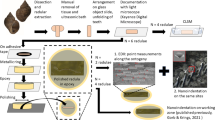Abstract
Through hundreds of millions of years of evolution, organisms have developed a myriad of ingenious solutions to ensure and optimize survival and success. Biological materials that comprise organisms are synthesized at ambient temperature and pressure and mostly in aqueous environments. This process, mediated by proteins, limits the range of materials at the disposal of nature and therefore the design plays a pivotal role. This article focuses on sharp edges and serrations as important survival and predating mechanisms in a number of plants, insects, fishes, and mammals. Some plants have sharp edges covered with serrations. The proboscis of mosquitoes and stinger of bees are examples in insects. Serrations are a prominent feature in many fish teeth, and rodents have teeth that are sharpened continuously, ensuring their sharpness and efficacy. Some current bioinspired applications will also be reviewed.
Similar content being viewed by others
References
U.G.K. Wegst and M.F. Ashby, “The Mechanical Efficiency of Natural Materials,” Phil. Mag., 84 (2004), pp. 2167–2181.
M.A. Meyers et al., “Biological Materials: Structure and Mechanical Properties,” Progress in Materials Science, 53 (2008), pp. 1–206.
M.A. Meyers et al., “Structural Biological Composites: An Overview,” JOM, 58(7) (2006), pp. 35–41.
E. Arzt, “Biological and Artificial Attachment Devices: Lessons for Materials Scientists from Flies and Geckos,” Materials Science and Engineering C, 26(8) (2006), pp. 1245–1250.
M.F. Ashby and K. Johnson, Materials and Design (Oxford, U.K.: Butterworth-Hinemann, 2003).
K. Oka et al., “Fabrication of a Microneedle for a Trace Blood Test,” Sensors and Actuators A, 97–98 (2002), pp. 478–485.
T. Ikeshoji, The Interface between Mosquitoes and Humans (Tokyo: University of Tokyo Press, 1993), pp. 189–214.
J.M. Diamond, “How Great White Sharks, Saber-Toothed Cats and Soldiers Kill,” Nature (London), 322 (1986), pp. 773–774.
R.A. Martin et al., “Predatory Behaviour of White Sharks at Seal Island, South Africa,” J. Mar. Biol. Ass. U.K., 85 (2005), pp. 1121–1135.
T.H. Frazzetta, “The Mechanics of Cutting and the Form of Shark Teeth (Chondrichthyes, Elasmobranchii),” Zoomorphology, 108 (1988), pp. 93–107.
L.O. Lucifora, R.C. Menni, and A.H. Escalante, “Analysis of Dental Insertion Angles in the Sand Tiger Shark, Carcharias Taurus Chondrichtheyes: Lamniformes,” Cybium, 25(1) (2001), pp. 23–31.
K. Shimada, “Dental Homologies in Lamniform Sharks (Chondrichthyes: Elasmobranchii),” Journal of Morphology, 251 (2992), pp. 38–72.
W.L. Abler, “The Serrated Teeth of Tyrannosaurid Dinosaurs, and Biting Structures of Other Animals,” Paleobiology, 18 (1992), pp. 161–183.
Jürgen Berling and Marcus Rechberger, “Knives as Sharp as Rat’s Teeth,” Research News 1 (Oberusel, Germany: Fraunhofer Institute for Environmental, Safety and Energy Technology, October 2007), Topic 3, www.fraunhofer.de/fhg/EN/press/pi/2005/01/Mediendienst012005Thema3.jsp.
Author information
Authors and Affiliations
Corresponding author
Rights and permissions
About this article
Cite this article
Meyers, M.A., Lin, A.Y.M., Lin, Y.S. et al. The cutting edge: Sharp biological materials. JOM 60, 19–24 (2008). https://doi.org/10.1007/s11837-008-0027-x
Published:
Issue Date:
DOI: https://doi.org/10.1007/s11837-008-0027-x




